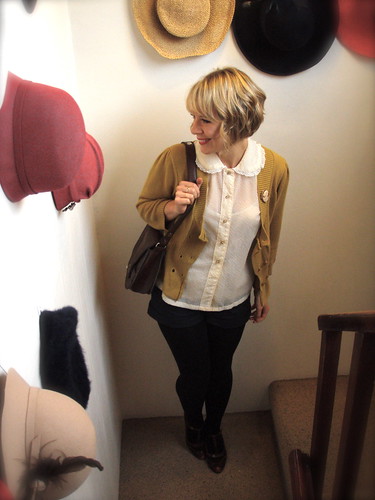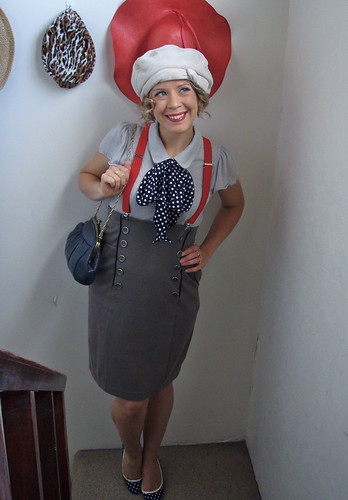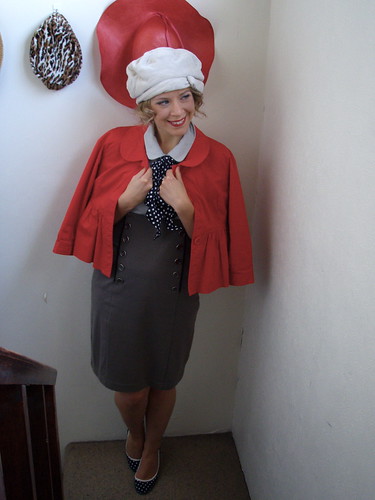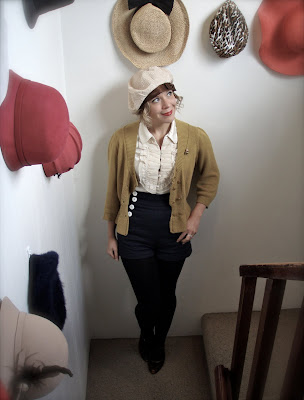
Thank you so much for all your comments on the previous posts, everyone! If you haven't had a chance to read through the comments yet, you should definitely do so when you get the chance - there are some excellent points and tips in there.
Mending and altering
I know a lot of you are extremely skilled seamstresses and can do most alterations yourselves, but I'm afraid I am not. I can hem garments, take them in and make small repairs, but that's about all. If the garment is vintage, or special in some way, I prefer to take it to my lovely dressmaker, because I trust her to do a far better job than I! (Although I did attack a vintage dress with scissors and thread one Chardonnay-fuelled night. I woke up in the morning with hazy recollections, thinking I had ruined it - it actually looked quite good, but that was sheer luck. The moral of the story is that wine and alterations do not mix).
There is nothing more elegant than a perfectly-fitted garment, and I think it pays to become fussy about the fit of your clothes. Alterations are not usually expensive (although it pays to factor in the cost of alterations when thrifting a garment that doesn't fit, as it may turn out to be less of a bargain than you thought) and they make an enormous difference. The only advice I would give is that I think it's best to take the garment to the dressmaker as soon as possible - it's easy to develop a pile of to-be-altered garments, and it's less overwhelming if you take them in straight away. It also means you'll be able to incorporate the items into your wardrobe - and wear them! - more quickly.
Cleaning
I'm not an expert on any of this; these are just the methods I use! I know that many of you have infinitely more experience and knowledge in this area than I do, so please add any further tips and tricks in the comments. Advice on cleaning special items, like hats (Solanah, are you out there? I have a feeling you'll be an expert on this!) and vintage swimsuits would be fantastic.
Washing vintage clothing
Okay. I'm going to make a confession here. I do wash some of my vintage dresses, the cotton ones, in the washing machine - in warm water on the Delicates cycle, with detergent designed for delicate fabrics. I know this makes me a bad, bad person, but - what can I say? I really hate hand-washing. The one drawback of having a large vintage wardrobe, however, is that you do need to do a lot of hand-washing, even if you cheat with the washing machine occasionally, and it is certainly the best way to wash your newly-acquired thrifted vintage for the first time. I wash each item separately in a little basin, in lukewarm water, with a delicate detergent (without agitating the garments in the water), and then rinse them in fresh water (without scrunching and wringing them). I then dry the dresses flat, in the shade. When it comes to ironing, I use a fairly cool iron, and place a thin cloth (like a napkin) between the iron and the garment. It's a good idea to check if this will work on a small section of the garment first, just in case it explodes or melts or something! I also hang garments in the shower room in the mornings to steam.
As a general rule, you can wash cotton, linen, man-made fabrics and some wool blends by yourself (although there are always exceptions). There are some fabrics, of course, that need to be dry-cleaned. I think it's a good idea to ask the owner of your favourite vintage store which dry-cleaner they use, as then you can be sure that they know how to deal with vintage fabrics.
Basically, when in doubt, get it cleaned by a specialist!
In addition, don't wash your vintage clothing too often, as it speeds its deterioration. We're a bit spoiled with laundry, anyway, in the Western world, and wash our clothes more than is necessary. As a well-brought-up little Zimbabwean girl, in a country where water is a scarce resource, I was taught to keep laundry to a minimum, and I think it was good advice.
Consider buying some dress shields, as underarm sweat is a vintage fabric's Kryptonite. They will help to preserve the fabric, as well as keeping the dress cleaner and sweeter-smelling! If your garment has yellow underarm stains, these can be tricky ... try dabbing at them with white vinegar on clean cloth. This can improve things, but I've never had much luck with it. As always, if you have any tips, please chime in in the comments!
Cleaning shoes
I know a lot of people don't like the idea of buying second-hand shoes, but it's not something that makes me squirm. I will say, though, that I usually only thrift new or near-new shoes - you'd be amazed how often people give away band-new shoes! I do, however, clean the insides with white spirits on a bit of cotton wool, to kill any lurking nasties. You can buy new in-soles, too, to reduce the ick factor.
Cleaning rare or historic items
I don't own any items of clothing that could be museum pieces, but there is a chance that you may fall in love with a rare find from the Victorian era, or one of those gorgeously delicate beaded dresses from the 20s. If so, the garment may be too delicate to clean, or even to wear, but if you want to conserve it, there are conservators who specialise in antique fabrics and who will be able to help you preserve it in a good state. If you are having trouble finding a good conservator, ask at your local museum - they will usually be able to recommend someone. A good friend of mine works as a conservator here in Christchurch, and the bulk of her clients comes from museum referrals.
Storing and displaying your vintage clothing
I am hardly a shining example of proper storage, as my husband and I share a closet the size of a Porta-Loo and my clothes are living in cramped quarters. Basically, though:
As for hats - well, you've all seen my stairwell of hats! This isn't the ideal home for them, as there is a small window in the stairwell and they may fade, but they look so pretty. Hatboxes are much better - and they look gorgeous, too! You can buy plain ones in lots of different sizes at craft stores, and decorate them yourself. I think they look great covered in pretty wallpaper. When storing your hat in the box, stuff the crown with tissue paper to keep its shape.
If you do not already have a dressmaker you visit regularly, ask friends and family for recommendations. I found mine by asking the owner of a vintage store who she used - that way I could be sure that they were used to handling vintage garments.
Cleaning
I'm not an expert on any of this; these are just the methods I use! I know that many of you have infinitely more experience and knowledge in this area than I do, so please add any further tips and tricks in the comments. Advice on cleaning special items, like hats (Solanah, are you out there? I have a feeling you'll be an expert on this!) and vintage swimsuits would be fantastic.
Washing vintage clothing
Okay. I'm going to make a confession here. I do wash some of my vintage dresses, the cotton ones, in the washing machine - in warm water on the Delicates cycle, with detergent designed for delicate fabrics. I know this makes me a bad, bad person, but - what can I say? I really hate hand-washing. The one drawback of having a large vintage wardrobe, however, is that you do need to do a lot of hand-washing, even if you cheat with the washing machine occasionally, and it is certainly the best way to wash your newly-acquired thrifted vintage for the first time. I wash each item separately in a little basin, in lukewarm water, with a delicate detergent (without agitating the garments in the water), and then rinse them in fresh water (without scrunching and wringing them). I then dry the dresses flat, in the shade. When it comes to ironing, I use a fairly cool iron, and place a thin cloth (like a napkin) between the iron and the garment. It's a good idea to check if this will work on a small section of the garment first, just in case it explodes or melts or something! I also hang garments in the shower room in the mornings to steam.
As a general rule, you can wash cotton, linen, man-made fabrics and some wool blends by yourself (although there are always exceptions). There are some fabrics, of course, that need to be dry-cleaned. I think it's a good idea to ask the owner of your favourite vintage store which dry-cleaner they use, as then you can be sure that they know how to deal with vintage fabrics.
Basically, when in doubt, get it cleaned by a specialist!
In addition, don't wash your vintage clothing too often, as it speeds its deterioration. We're a bit spoiled with laundry, anyway, in the Western world, and wash our clothes more than is necessary. As a well-brought-up little Zimbabwean girl, in a country where water is a scarce resource, I was taught to keep laundry to a minimum, and I think it was good advice.
Consider buying some dress shields, as underarm sweat is a vintage fabric's Kryptonite. They will help to preserve the fabric, as well as keeping the dress cleaner and sweeter-smelling! If your garment has yellow underarm stains, these can be tricky ... try dabbing at them with white vinegar on clean cloth. This can improve things, but I've never had much luck with it. As always, if you have any tips, please chime in in the comments!
Cleaning shoes
I know a lot of people don't like the idea of buying second-hand shoes, but it's not something that makes me squirm. I will say, though, that I usually only thrift new or near-new shoes - you'd be amazed how often people give away band-new shoes! I do, however, clean the insides with white spirits on a bit of cotton wool, to kill any lurking nasties. You can buy new in-soles, too, to reduce the ick factor.
Cleaning rare or historic items
I don't own any items of clothing that could be museum pieces, but there is a chance that you may fall in love with a rare find from the Victorian era, or one of those gorgeously delicate beaded dresses from the 20s. If so, the garment may be too delicate to clean, or even to wear, but if you want to conserve it, there are conservators who specialise in antique fabrics and who will be able to help you preserve it in a good state. If you are having trouble finding a good conservator, ask at your local museum - they will usually be able to recommend someone. A good friend of mine works as a conservator here in Christchurch, and the bulk of her clients comes from museum referrals.
Storing and displaying your vintage clothing
I am hardly a shining example of proper storage, as my husband and I share a closet the size of a Porta-Loo and my clothes are living in cramped quarters. Basically, though:
- Make sure your clothes are clean before storing them
- Keep them away from light, as they will fade and become damaged
- Try and keep as much air between each garment as possible
- Hang scented bags in the wardrobe to make them smell lovely and to keep away insects - cedar oil is good for repelling moths!
As for hats - well, you've all seen my stairwell of hats! This isn't the ideal home for them, as there is a small window in the stairwell and they may fade, but they look so pretty. Hatboxes are much better - and they look gorgeous, too! You can buy plain ones in lots of different sizes at craft stores, and decorate them yourself. I think they look great covered in pretty wallpaper. When storing your hat in the box, stuff the crown with tissue paper to keep its shape.
Please do add your thoughts, everyone, as this is such a huge subject! I'd love to know any information you'd like to share.
P.S. Woman of the Week is suspended this week while I do this series - back next week!
































